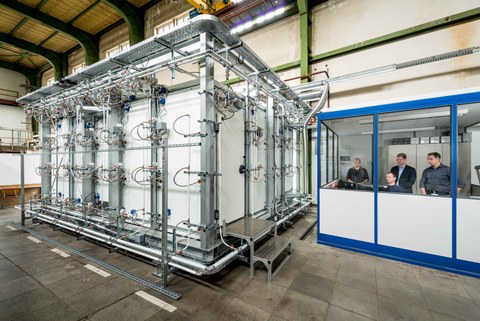May 25, 2016
Start of the Research Project SOMAK

The Climate Chamber of the Dresden-based scientists will be the first to benefit from the new technology: The SOMAK prototype will be tested in this air conditioning unit.
Interdisciplinary Research Team Develops Innovative Climate Technology
Federal Ministry for Economic Affairs and Energy Finances New Research Project with 1.7 Million Euros
The 26 May 2016 signals the start of the research project SOMAK: solar magnetic climate control for buildings. Until 2020, engineers at the TU Dresden together with the Leibniz Institute for Solid State and Materials Research will be developing a new technology to make air conditioning more environmentally friendly and more efficient. The innovation: the cooling process is based on a natural process (cooling produced by evaporation) and integrates local energy resources. For the first time, scientists are harnessing the so-called magnetocaloric effect. The Federal Ministry for Economic Affairs and Energy is financing the project with 1.72 million Euros.
Currently, most buildings are air conditioned with conventional cooling technology that consumes a lot of energy. This is not only environmentally unfriendly, it’s also expensive. Dr. Joachim Seifert, SOMAK’s project leader: “A major part of the primary energy in office buildings in Germany is used for air conditioning. To successfully implement the transition to sustainable energy, the development of more efficient technologies is key.”
Although air conditioning systems based on cooling from evaporation have already been developed in recent years, their performance is limited. This is the starting point for the scientists in this project: they are combining the evaporation process with a magnetocaloric process that taps additional cooling capacity. A suitable material is then exposed to an alternating magnetic field that produces heat and cold. Both can be used in the air conditioning process. The magnetocaloric module can theoretically produce ca. 30% more effectively than a comparable heat pump, which will be practically proven in the project. With this, the engineers are exploiting a new technology: “We are the first to examine how the magnetocaloric effect can be used in air conditioning; we’re working here in Dresden on a little worldwide innovation,” says Seifert. Another advantage: the system is connected to a solar facility and therefore largely self-regulating.
The vision: the ultimate goal is a module that can be installed in existing air conditioning systems to substantially increase their efficiency. The next step for the researchers is to develop a prototype that can be tested for suitability. Power engineers and electrical engineers from the TU Dresden are working closely with materials scientists from the Leibniz Institute for Solid State and Materials Research. In order to guarantee the successful transfer of technology, the scientists have also teamed up with industry partners. The plant manufacturer Glen Dimplex would like to transform the prototype into a product, and the engineering firm INNIUS, which was involved in the planning of the Frankfurt Airport, will support its marketing.
Information for journalists:
PD Dr.-Ing. habil. Joachim Seifert, project leader SOMAK
Technische Universität Dresden
Faculty of Mechanical Science and Engineering, Institute of Power Engineering
Chair of Building Energy Systems and Heat Supply
Tel.: +49 (0) 351 463-34909
